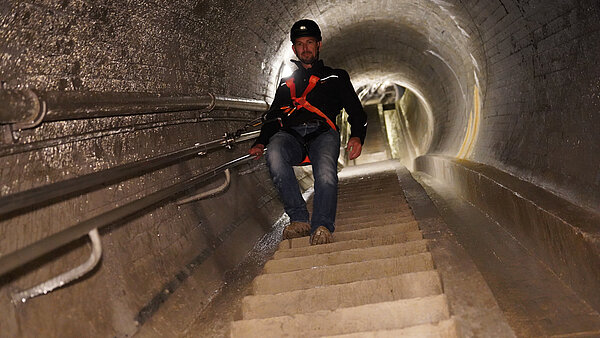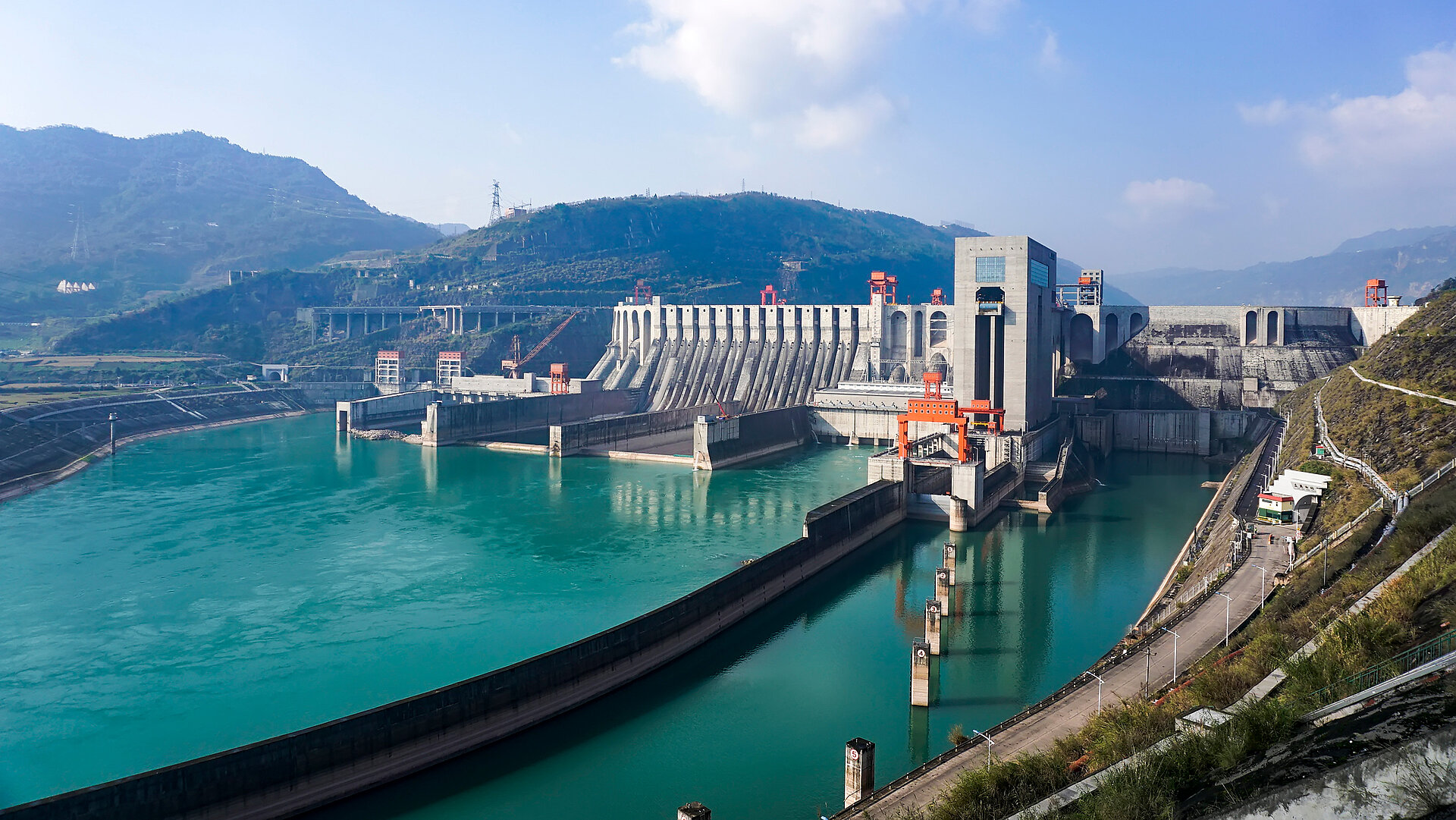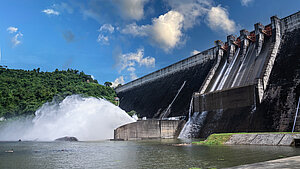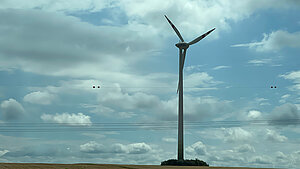Compliance with the applicable safety guidelines, combined with regular inspections and ongoing appropriate training sessions for employees, is decisive when it comes to minimising the dangers and creating a safe working environment for the people at risk.
In this post, for a hydro-electric plant we present our top 4 danger areas indoors and the top 4 danger areas outdoors, plus suitable work safety measures to protect against them. In addition we briefly explain what requires attention, and the fall protection systems that can be used to protect these areas.
Protection of employees and service workers against falls in and on hydro-electric plants is an obvious item in our listing. Nevertheless, it is worth mentioning that at these workplaces, numerous additional risks exist. Examples of these include high-voltage installations, some chemicals, and also the high pressure permanently acting on the barrage walls, as well as water potentially contaminated by industry or agriculture, and the often very high noise level.
Fall dangers indoors
- Machinery and turbines:
In particular, the rotating parts of turbines and other machinery require appropriate protection to prevent service technicians and maintenance workers from coming into contact with them. It may also become necessary to access large machinery and equipment. Appropriate, professional protection against falls must also be provided here.
- Restricted views and lack of space:
In particular, the entry and exit to/from shafts through narrow openings often represent a very high potential danger. In addition, maintenance routes, as well as descents, stairways, and ascent ladders, are generally very narrow and steep. The very restricted views are yet another risk factor here. All this requires a safety system adapted to the situation, and it needs to facilitate ease of movement.
- Pits and shafts:
In some cases, employees have to climb down into pits and shafts to perform servicing and maintenance tasks. To minimise the fall risk, it is important that these areas are protected by suitable fall protection systems, including anti-fall PPE.
- Working close to water:
Water is ever-present, even indoors. The employees must therefore be protected continuously, so that slips on wet surfaces cannot result in injuries or in even worse consequences, such as drowning.
Dangers outdoors
- Water flows and levels:
In the outdoor area of barrages, continuously changing water levels and flows are one of the key challenges from a safety-technical viewpoint, because unforeseeable, dangerous situations for the employees can arise repeatedly. Here too, service technicians and maintenance workers must be appropriately protected against falling, so that they are not dragged away by water flows.
- Narrow maintenance routes:
Even away from the barrage walls and hydro-electric equipment, maintenance routes are mostly narrow and, in addition, directly adjacent to flowing water. Particularly after extended periods of heavy rain, driftwood can be carried down, and this must be removed to prevent log jams. Naturally, this activity must be protected by professional, certified systems.
- Fish ladders:
In Austria, Germany, and Switzerland it must be ensured that fish can pass through the hydro-electric plants completely unhindered. This also includes regular cleaning and maintenance of the fish ladders. For this, the workers must also be protected against falls. Find out here what this can look like in practice.
- Roofs and canopies:
For maintenance tasks on roofs and canopies of buildings or structures in a hydro-electric plant, the danger from falls is particularly serious. Here, suitable fall protection systems such as guardrails or a rail or lifeline system should be used to eliminate the danger which exists.
A selection of potential safety solutions in and on hydro-electric plants
Selection of the optimum fall protection system always depends greatly on the actual situation and the characteristics of the workplace. Thus, for the outside wall of a barrage, the TAURUS rail system is ideally suited for protecting against falls; for fish ladders, as shown by the practical example of the illwerke power generation company, the AIO lifeline system is a very good choice.
It is essential that potential dangers and risks are recognised and recorded in the form of a risk assessment, and that suitable measures to protect against them are specified.
AIO lifeline system:
The hydro-electric plant of the illwerke vkw company is an example of how the AIO lifeline system is optimally suited as a safety solution for fish ladders. This is where the AIO Lifeline Passable Overhead System was installed to reliably protect the workers from falling into the flowing water.
The great advantage of this solution is that it can be adapted, even to complex structures, and it can also be installed very rapidly and efficiently, because of its modular components. In addition, the AIO lifeline system is characterised by its very good free-running characteristics.
TAURUS rail system:
The TAURUS rail system is ideally suited for protecting the outside wall of a barrage. However, because of its very good adaptability, this solution is also used for numerous areas inside a barrage. The TAURUS ALLROUND rail system provides the best possible continuous protection for all inclined descents and transitions.
The TAURUS ALLROUND is highly suitable because of the adaptability of the rails, even for complex structures. Curves, horizontal or vertical planes, or even transitions present no problems to the user-friendly system.
EAP single anchor points:
For protecting shaft entries, EAP single anchor points such as the EAP-TEL-10 are an optimum choice. It is mobile and can be used multiple times, i.e. it can be transported with ease in a backpack. The mount for the EAP-TEL-10, the EAP-TEL-20-VZ, is telescopic, and it can be attached without tools.
This individual protection solution is highly recommended, especially when several shafts are included in one maintenance schedule. EAPs must always be used in combination with anti-fall PPE.
But the TAURUS-SCE-10 in combination with the TAURUS-SCE-50-A4 shaft bracket and the TAURUS rail system is also frequently used to protect descents and ascents into and out of shafts. This push-on support is removable and mobile. It is installed onto the existing ladder in the shaft, and onto the installed TAURUS VERTIKAL. This enables continuous protection of descents and ascents in shafts.
INFO: The role of personal protective equipment (PPE) in shaft descents:
Anti-fall PPE acts as the link between the respective fall protection system and the employees to be protected. Before descending, the person in the danger area uses a fall arrest device to attach herself/himself to one of the two anchorage eyes on the telescopic post of the single anchor point.
BARRIER guardrail system:
To ensure safety when accessing the outside area of a hydro-electric plant along its fall edge, collective protection such as our BARRIER system can be installed. This protection is also recommended around an ascent ladder after the ascent/descent, and for protection when working on large machinery.
Maintenance of the safety solution
Not just the hydro-electric plant itself, but also the fall protection system and all associated elements must be maintained and inspected annually. These maintenance tasks must be performed only by appropriately trained employees who are certified in the respective safety solutions.
The inspections check whether defects have arisen over time in the anchorage line and cable, thus representing a safety risk. Load tests are also performed in the course of these maintenance tasks.
And: The anti-fall PPE, helmets, and life jackets must also be inspected regularly, because here too small cracks or other indications of wear can arise, requiring immediate replacement of the equipment. The general rule is: Anti-fall PPE must be replaced at least once every ten years.
Summary
As a workplace, a hydro-electric plant presents a number of danger areas. Regardless whether indoors or outdoors, the risk of falling or slipping exists for very many activities. For this reason, professional, certified fall protection systems must be implemented to protect employees appropriately, and to create safety for barrages and hydro-electric plants.
Contact us immediately if you have questions about the safety of your hydro-electric plant. Our experts will be pleased to help and advise. An information sheet about fall protection at hydro-electric plants is also available to download free of charge.














